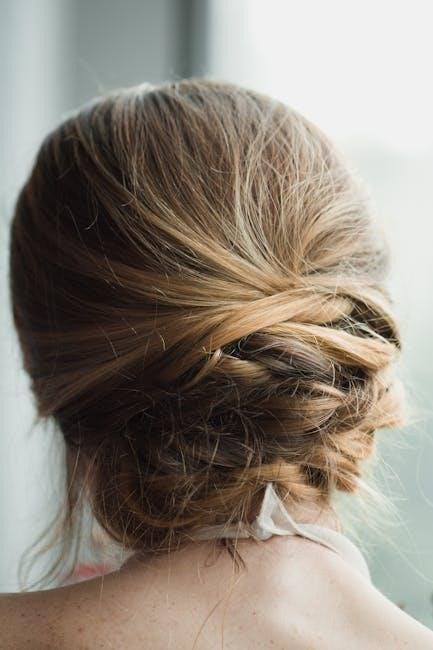hair length guide
Understanding hair length is crucial for styling and maintenance. This guide helps determine accurate measurements, offers tips, and explores how length enhances appearance and personal style effectively.
1.1 Overview of Hair Length and Its Importance
Hair length plays a pivotal role in personal style and first impressions. It frames the face, enhances features, and reflects cultural identity. Understanding its importance helps in choosing styles that complement one’s aesthetic. Whether short, medium, or long, hair length significantly impacts overall appearance. It also influences maintenance routines and lifestyle preferences, making it a key factor in grooming decisions. Thus, recognizing its impact is essential for making informed styling choices.
1.2 The Purpose of a Hair Length Guide
A hair length guide serves as a comprehensive tool for measuring, understanding, and selecting the ideal hair length. It assists in determining accurate measurements, offers styling tips, and helps choose lengths that suit face shape, texture, and lifestyle. This guide empowers individuals to make informed decisions, ensuring their hair reflects their personal style and preferences effectively. It also aids in tracking growth and maintaining desired looks.

How to Measure Hair Length Accurately
Use a tape measure from the scalp to hair ends for precise length. Ensure hair is dry and straight for accuracy, especially for curly or wavy textures.
2.1 Tools and Methods for Measuring Hair
Use a soft tape measure or ruler to measure hair length from the scalp to the ends. For accuracy, comb hair straight and measure when dry. Alternatively, AI tools analyze hair length from images, categorizing it into distinct lengths. These methods ensure precise measurement for styling or tracking growth, suitable for all hair types and textures.
2.2 Special Considerations for Curly and Wavy Hair
Curly and wavy hair can appear shorter due to shrinkage, which may reduce visible length by up to 75%. To measure accurately, straighten the hair or stretch curls gently while measuring. This ensures true length is captured, helping to choose styles that complement natural texture and avoid misleading measurements when styling or tracking growth progress over time.
Understanding Hair Length Charts
Hair length charts provide a structured way to measure and categorize hair, helping to determine styles, track growth, and choose extensions accurately for every hair type.
3.1 Standard Hair Length Charts
Standard hair length charts categorize hair into defined measurements, such as ear-length, chin-length, shoulder-length, and mid-back-length. These charts help individuals and stylists determine suitable styles, extensions, and growth tracking. They often include visual references for various hair types, ensuring accurate measurements and style choices that complement different textures and preferences;
3.2 Visual References for Different Hair Types
Visual references provide detailed illustrations for various hair types, including straight, curly, wavy, and coily textures. These guides help individuals identify their hair length accurately, considering natural shrinkage in curly hair. Charts often include images or diagrams, making it easier to match hair length to personal style preferences and cultural trends for a more informed decision-making process.

Popular Hair Lengths and Styles
Explore trendy hair lengths, from chic pixie cuts to elegant long braids. Discover versatile styles that suit every face shape, lifestyle, and personal preference seamlessly;
4.1 Short Hair: Pixie Cuts and Bobs
Short hair styles like pixie cuts and bobs are chic and low-maintenance. A pixie cut, typically 2-4 inches long, offers an edgy look, while a chin-length bob, around 8-10 inches, provides timeless elegance. These styles enhance facial features and suit various lifestyles, making them popular choices for modern individuals seeking practical yet stylish options.
4.2 Medium Hair: Shoulder and Mid-Length Styles
Medium hair, ranging from shoulder-length (12-14 inches) to mid-length (16-18 inches), offers versatility and ease. Shoulder-length styles frame the face beautifully, while mid-length hair allows for various styling options like waves, braids, or ponytails. This length is ideal for those seeking a balanced look that complements most face shapes and lifestyles, making it a timeless and popular choice.
4.3 Long Hair: From Waist-Length to Tailbone-Length
Long hair, typically waist-length (18-20 inches) to tailbone-length (28-30 inches), exudes elegance and versatility. It allows for diverse styling, from loose waves to intricate updos. Regular conditioning and trims are essential for maintaining health. While high maintenance, long hair offers endless possibilities for creativity and timeless beauty, making it a favored choice for those who enjoy experimenting with different looks and styles.
Choosing the Right Hair Length for You
Choosing the right hair length involves analyzing face shape, hair texture, and lifestyle preferences. It ensures a flattering and practical style that complements personal features and daily routines effectively.
5.1 Considering Face Shape and Features
Face shape significantly impacts hair length choices. Oval faces suit most lengths, while round faces benefit from longer styles to elongate. Square faces look best with soft, rounded cuts. Measure from the crown to hair ends and consider facial symmetry for a balanced look that enhances natural features and personal style effectively.
5.2 Lifestyle and Maintenance Preferences
Your lifestyle and maintenance habits play a key role in choosing hair length. Busy individuals may prefer low-maintenance short styles, while those with more time can manage longer lengths. Consider your daily routine, activity level, and willingness to style regularly. Match your hair length to your lifestyle for a practical, stress-free look that aligns with your personal preferences and daily commitments.

Styling Tips for Different Hair Lengths
Explore versatile styling ideas tailored to your hair length. From sleek updos for long hair to edgy textures for short styles, find tips to enhance your look effortlessly.
6.1 Short Hair Styling Ideas
Short hair offers chic and low-maintenance options. Try a pixie cut for an edgy look or a bob that skims the chin for timeless elegance. Use texturizing products to add volume and definition, and embrace bold accessories or subtle understyling for a personalized touch that complements your unique features and lifestyle effortlessly.
6.2 Medium Hair: Versatile Styling Options
Medium hair offers endless versatility, suiting various styles and preferences. Shoulder and mid-length cuts can be styled sleek and straight, wavy, or braided. Layered cuts add movement, while updos and half-up styles offer elegance. This length is ideal for balancing ease of maintenance with creative expression, making it perfect for both casual and formal occasions with minimal effort.
6.3 Long Hair: Braids, Updos, and More
Long hair offers a canvas for creativity with styles like braids, ponytails, and updos. From sleek buns to intricate fishtail braids, it’s perfect for special occasions. Waist-length hair can be styled in loose waves for a romantic look, while tailbone-length locks allow for elaborate designs. Regular maintenance ensures healthy, luscious hair that turns heads wherever you go effortlessly.

Hair Length and Cultural Significance
Hair length carries deep cultural and historical meaning, often symbolizing social status, gender roles, and identity. Styles evolve, blending tradition with modern trends to reflect societal values and aesthetics.
7.1 Historical Perspectives on Hair Length
Hair length has historically symbolized social status, gender roles, and cultural identity. In ancient civilizations, elaborate hairstyles denoted wealth and power, while in other cultures, long hair signified spirituality or marital status. During the Middle Ages, women’s hair was often covered, and in the 1920s, shorter styles emerged as a symbol of liberation. Hair length continues to reflect societal norms and cultural values, evolving over time while maintaining its symbolic significance.
7.2 Cultural Trends in Hair Length Today
Today, cultural trends in hair length vary widely, reflecting diversity and personal expression. Short hair is embraced for its chic, low-maintenance appeal, while long hair remains a timeless symbol of elegance and cultural heritage. Globally, bold shorter styles dominate in some regions, while others prefer traditional longer lengths, highlighting the enduring significance of hair length in cultural identity and personal aesthetics.
Face Shape Considerations
Face shape significantly influences hair length choices, ensuring balance and harmony between aesthetics and personal features, helping individuals find flattering styles that enhance their natural beauty and structure.
8.1 How to Determine Your Face Shape
Determining your face shape is key to choosing the right haircut or extensions. Use a flexible measuring tape to measure across your brow, cheeks, and jawline. Analyze your angles and proportions to identify if your face is oval, round, square, heart-shaped, or triangular. Knowing your face shape helps guide hair length and style choices for a balanced, flattering look.
8.2 Hair Length Recommendations by Face Shape
For oval faces, any hair length works well; Round faces benefit from longer styles that elongate the silhouette, while square faces look best with soft, layered cuts. Heart-shaped faces are flattered by chin-length or shorter styles, and triangular faces suit longer hair with volume at the top. Tailoring hair length to face shape enhances balance and complements natural features for a polished look.
Tracking Hair Growth
Tracking hair growth involves regular measurements from scalp to ends. Use a tape measure for accuracy, especially for curly hair. Consider a tracker app to monitor progress and set realistic goals, helping maintain motivation and achieve desired length.
9.1 Methods for Monitoring Hair Growth
Accurately track hair growth by measuring from the scalp to ends using a tape measure. For curly hair, straighten strands before measuring to avoid shrinkage. Use a hair growth journal or app to log progress, take monthly photos, and compare over time. Regular documentation helps identify patterns and maintain motivation. Measure hair when dry for consistent results.
9.2 Setting Realistic Hair Growth Goals
Set achievable goals based on average hair growth rates of 0.5 inches per month. Consider genetics, health, and hair care routines when defining expectations. Break long-term goals into shorter milestones for motivation. Use a hair growth journal or app to track progress visually. Be patient, as consistent effort and proper care are key to reaching desired lengths over time.
Hair Extensions and Hair Length
Hair extensions offer versatile solutions to achieve desired lengths instantly. Measure accurately for a seamless fit, considering hair type and style preferences to enhance your natural look effectively.
10.1 Choosing the Right Length for Extensions
Choosing the right length for extensions involves measuring your natural hair and considering your face shape, hair texture, and personal style. Ensure the extensions blend seamlessly with your natural hair for a cohesive look. Measure from the crown to desired ends, and consult with a professional to achieve the perfect match for your lifestyle and aesthetic goals.
10.2 Measuring for a Perfect Fit
Accurate measurement is key for extensions. Use a soft tape measure, starting at the crown and extending to the desired length; Ensure hair is dry and straight for precise results. For curly or wavy hair, measure when straight to account for shrinkage. This ensures a seamless blend and natural-looking fit for your extensions.
11.1 Summary of Key Points
This guide helps determine ideal hair length using tools like tape measures and charts. Consider face shape, hair type, and lifestyle for the best fit. Styling options vary by length, from short pixies to long braids. Tracking growth and setting realistic goals ensures success. Ultimately, choosing the right length balances aesthetics and practicality for a personalized look that enhances your features and suits your preferences perfectly.
11.2 Final Advice for Choosing Your Ideal Hair Length
Consult a professional for personalized recommendations. Consider your face shape, lifestyle, and hair texture when selecting a length. Experiment with temporary styles to test preferences. Be patient with growth and maintenance, ensuring regular trims for health. Remember, confidence is key—choose a length that makes you feel your best and complements your unique features and personal style effortlessly.


